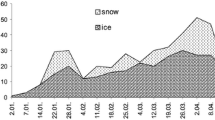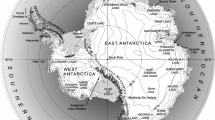Abstract.
The microbial communities and photosynthetic capacity of cryoconite holes on the Midre Lovénbreen Glacier at 79°N in Spitzbergen (Svalbard Archipelago) were investigated in July/August 2000 and July 2001. The constituents of the microbial assemblages were more abundant in material on the cryoconite bottoms than in the overlying water. Bacterial concentrations ranged from 1.00 to 4.50×104 ml–1 in the water and from 4.67 to 7.07×104 ml–1 in the bottom material; virus-like particles (VLP) ranged from 3.97 to 12.70×104 ml–1 in the water and from 27.5 to 37.59×104 ml–1 on the bottom. VLP: bacteria ratios ranged between 0.24 and 8.11, with highest ratios in the bottom assemblages. Heterotrophic nanoflagellate (HNAN) abundances were significantly lower than those of the autotrophic nanoflagellates (PNAN). Moreover, HNAN biomass was lower than bacterial biomass, indicating that the HNAN were exploiting other energy sources as well as bacteria, for example, VLP and dissolved organic carbon. The bottom material was dominated by cyanobacteria (mostly Phormidium sp.), while both the water and the bottom layer contained a small number of chlorophyte species (Chlorella sp., Cylindromonas sp. and Chlamydomonas nivalis). Ciliates were very sparse, only occurring on the bottom. On occasions, the glacier surface carried meltwater with well-developed biofilms, in which ciliates (Monodinium, Strombidium and Halteria) occurred. All of these species are found in nearby lakes. One to three rotifers were noted in the biofilm samples and in samples from three of the cryoconite holes. The assemblages of the cryoconite holes were comparable to the truncated food webs seen in Antarctic lakes, but were even more simplified and sparse in terms of biomass. Photosynthesis in the meltwater on the glacier surface ranged between 0.60 and 8.33 µg C l–1 h–1. Within the cryoconites, photosynthetic rates were usually highest on the bottom (0.63–156.99 µg C l–1 h–1), while in the overlying water, rates ranged between 0.34 and 10.56 µg C l–1 h–1. Given the density of cryoconite holes (circa 6% of the glacier surface, or 12 holes m–2), there was significant carbon fixation and nutrient cycling occurring on the glacier, associated with cryoconite communities.
Similar content being viewed by others
Author information
Authors and Affiliations
Additional information
Electronic Publication
Rights and permissions
About this article
Cite this article
Säwström, C., Mumford, P., Marshall, W. et al. The microbial communities and primary productivity of cryoconite holes in an Arctic glacier (Svalbard 79°N). Polar Biol 25, 591–596 (2002). https://doi.org/10.1007/s00300-002-0388-5
Accepted:
Issue Date:
DOI: https://doi.org/10.1007/s00300-002-0388-5




